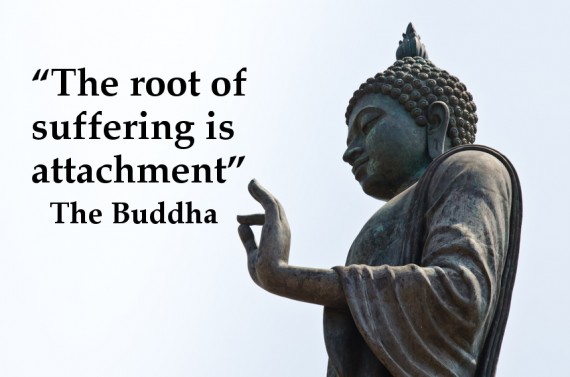
“It would be wonderful if you could recognize that your own attachment is the cause of every single problem that you experience.” ~ Lama Yeshe
.
It was day three of the 10-day residential Introduction to Buddhism course when our meditation instructor announced we’d be meditating on releasing attachment.
To be honest, I was anxiously waiting for it. I’ve been trying hard to let go of what no longer serves me, and I felt like this meditation had found its way to me at the right time.
The practice was so powerful that I burst into tears during and after it. It helped me realize how absurd my object of attachment is, and to my surprise, I was startled by the intensity of my clinging. It also helped me understand the nature of my attachment, the reasons behind it, and beautifully enough, it provided me with a swift yet effective method to release it.
I came to realize that when we get attached to someone or something, with time we tend to forget the suffering it has caused us. We extract the good feelings and dismiss the bad ones. When we reflect only on the desirable emotions that our object of attachment has generated, then we hold on even more tightly, thoroughly disregarding the misery it evoked.
Buddhists believe that attachment is the root of all our suffering. It lies deeply within us, and unless we recognize it and understand how it works, we will never be able to cut the cords. The object of our attachment varies from people to habits. We can be attached to a person, a certain drug, a particular reaction, to being right or perfect, a way of life, a job, a belief or opinions.
We cling to these opinions, reactions or people as it is in our very nature to hold on. Without this person or this drug, who are we? It is because of the imbalance of our minds and the insecurity that lies within us that we claim objects as “ours.” We mainly get attached because we are frightened to lose our object of attachment which in return threatens our ego.
Reflecting on my past dire attachments, I lived in a constant fear of losing a part of me if I were to lose whoever or whatever I was attached to. For me, letting go of attachment meant letting go of an immense space within me that constantly demanded to be filled.
Today, I admit that every person I have ever been attached to resulted from the insecurity I felt at that time. Owning things, people and even beliefs gave me a sense of incomparable safety and security.
Thinking about attachment now, I can see how others and I are constantly oscillating between love and hatred. Whatever we love, we get attached to, and whatever we hate, we reject. It is extremely difficult for us to love with balance—without grasping or owning.
Today, I am thoroughly convinced that it is of benefit to us and to others to release ourselves from attachment, because as long as we are driven by grasping, everything that we do (or will do) will be on a superficial level and will be utterly unbalanced. Once we peel away the layer of attachment, we shall truly experience freedom and true love.
After releasing our attachments and setting them free, we will come to realize that the root of our attachment was coming from our ego, which is constantly scared of not being liked, of being alone, of being wrong. When we recognize this, we will set our object of attachment free.
To put this meditation into practice, we must first sit crossed-legged or in any position that makes us comfortable. We close our eyes and focus on the breath coming in from the nostrils all the way down to the abdomen and vice-versa. Once we feel stabilized, we can start with the following steps. It is of benefit to dedicate at least three minutes for every step.
Step 1: Clearly imagine the object of attachment in front of you.
Step 2: Remember how this object made you unhappy.
Step 3: List your expectations from this person or this thing.
Step 4: What is it about it that made it so desirable?
Step 5: How does this object make you act? Do you ever become aggressive or greedy to get what you want?
Step 6: Does this attachment bring you happiness, or does it destroy your peace of mind?
The methods to overcome our attachment. (Keep your eyes closed, and proceed with the following steps.)
Step 7: Imagine holding on to your object of attachment, not wanting to lose it.
Step 8: Does this person or object have the power to bring you ever lasting happiness?
Step 9: Bit by bit, start mentally losing the grip and allow space between you and your object of attachment.
Step 10: Now that you have created space, are you able to enjoy this person or thing without grasping or clinging?
Step 11: See the object in front of you as impermanent, constantly changing. If it’s a person, visualize how this person will look like when they’re old. Watch how the object of your attachment right now, will change in 20 or 30 years.
Step 12: Imagine the people who don’t think your object of attachment is as attractive—people who think you’re mistaken. Remember what they tell you about it.
We can repeat this meditation as many times as necessary. Attachment is a hideous trip, and unless we recognize the unhealthy motivation behind it, we will never be willing to step out of its bus.
Let’s learn to be motivated by love rather than attachment. There is a fine line between the two, and crossing it will only do us and others harm.
~
Author: Elyane Youssef
Image: Flickr/Alice Popkorn
Editor: Yoli Ramazzina


 Share on bsky
Share on bsky





Read 0 comments and reply